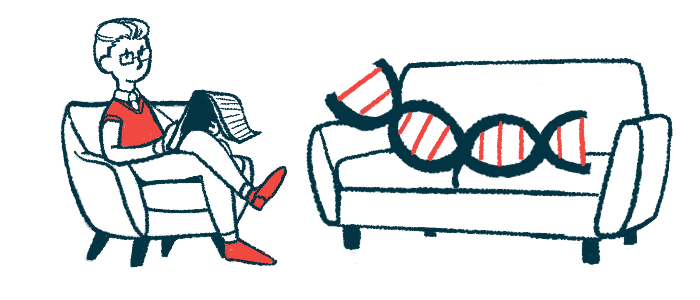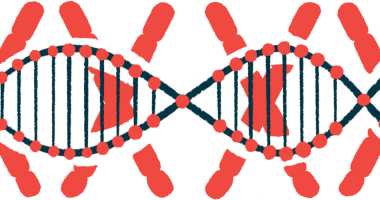Modified SMN protein aids gene therapy efficacy: Mouse study
SMN-K186R also found to have fewer side effects

SMN-K186R, a modified version of the SMN protein that is deficient in people with spinal muscular atrophy (SMA), was more effective than normal SMN when delivered by gene therapy, a mouse study demonstrated.
Treatment with lower doses of the modified SMN gene therapy, to reduce liver-related toxicity seen with current gene therapies, was still more effective than normal SMN.
“[SMN-K186R] has value as a new treatment for SMA that improves treatment effectiveness and reduces adverse events simultaneously,” the scientists wrote.
The study, “Improved therapeutic approach for spinal muscular atrophy via ubiquitination-resistant survival motor neuron variant,” was published in the Journal of Cachexia, Sarcopenia and Muscle.
SMA is caused by defects in the SMN1 gene, which leads to a deficiency in the SMN protein. A lack of SMN mainly affects motor neurons, the specialized nerve cells that control movement, resulting in muscle weakness and atrophy (shrinkage) over time.
Not all patients helped by approved therapy
Zolgensma (onasemnogene abeparvovec-xioi) is a gene therapy widely approved for newborns and toddlers up to age 2 with all types of SMA. Delivered to cells using a modified and harmless adeno-associated virus serotype 9 (AAV9), the therapy is designed to replace the faulty SMN1 gene and increase the levels of SMN protein.
Although clinical trials have shown that Zolgensma can improve motor skills and extend survival, some patients still fail to achieve motor milestones despite treatment before symptom onset. Moreover, in clinical trials some patients showed liver toxicity due to high AAV9 dosage, even after treatment with immunosuppressants.
Therefore, “drug development for an improved therapeutic effect for SMA patients is still needed,” the scientists wrote.
In cells, proteins are routinely produced and then degraded in an ongoing dynamic process, depending on cellular needs. Proteins targeted for degradation are tagged with a small protein called ubiquitin, a process called ubiquitination.
In previous work, the research team created a mutant version of the SMN protein, called SMN-K186R, that was resistant to ubiquitination but still retained its function in motor neurons. As a result, the levels of SMN-K186R were sustained for longer periods compared with normal SMN (SMN-WT).
Researchers have now developed an AAV9-based gene therapy, similar to Zolgensma, that delivers the genetic instructions for SMN-K186R to cells and tested its efficacy in a mouse model of severe SMA.
Control SMA mice treated with a mock therapy had an average lifespan of 14 days and survived about four weeks following treatment with SMN-WT. In contrast, mice given SMN-K186R lived an average of 164 days, representing an average lifespan extension of more than 140 days, about 10 times longer than without treatment.
Body weights paralleled the survival results. Untreated mice, or those treated with SMN-WT, initially gained weight and then lost weight until death, whereas mice given SMN-K186R gained weight and size comparable to healthy mice.
Tissue analysis found higher levels of SMN protein in the brain, spinal cord, and muscles in SMA mice treated with SMN-K186R compared with SMN-WT, a result related to ubiquitination resistance. Higher SMN levels due to SMN-K186R coincided with more motor neurons in the spinal cord, greater muscle mass, and thicker muscle fibers.
Mice respond to treatment
Several motor function tests showed the improved efficacy of SMN-K186R over SMN-WT. In response to gravity, mice treated with SMN-K186R turned their bodies upward successfully, unlike SMN-WT-treated mice, which failed to turn upwards beyond day 23. Hind-limb clasping upon tail suspension occurs in mice with motor deficits: whereas mice treated with SMN-K186R rarely showed this behavior, SMN-WT-treated mice displayed hind-limb clasping for more than 20 out of 30 seconds.
Due to the potential of treatment-related liver failure (hepatotoxicity) associated with gene therapy, the team examined the effects of SMN-K186R on the liver. By day 25, the average liver weight of mice treated with SMN-K186R was within the normal range, whereas SMN-WT-treated mice had significantly lighter livers.
While the number of liver cells was similar between the two groups, only mice treated with SMN-K186R showed liver cell growth comparable to that of healthy mice. Moreover, liver cells from SMN-WT-treated mice showed signs of SMN protein aggregation, which has been reported to cause defects in motor neurons.
When the dose of SMN-K186R was lowered to one-third of the clinical viral dose to reduce liver toxicity, SMN-WT-treated mice displayed hind-limb clasping, whereas mice treated with the lower dose of SMN-K186R showed no signs of motor deficits.
The higher stability and levels of SMN-K186R generated over SMN-WT did not cause neurotoxicity in the brain and spinal cord or showed early signs of neurotoxicity when delivered directly into the bloodstream.
“Our research suggests that an improved therapeutic approach for SMA via ubiquitination-resistant SMN, [SMN-K186R], will achieve better therapeutic effects in severe SMA newborn patients,” the scientists wrote. “The enablement of low AAV dose treatment from the improved treatment effects of [SMN-K186R] provides strong foundations for clinical applications in SMA patients to reduce hepatotoxicity.”









